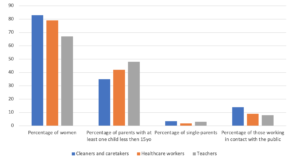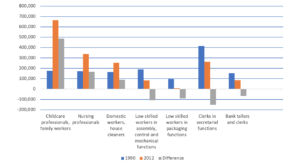
Written by Gabriele Mariani
The Covid-19 pandemic has revealed the key role that care professionals play in our society, along with other essential workers like educators, cleaners, and senior carers. The health risks and the long working hours to which these workers have been exposed have further revealed the inadequate social and economic recognition of their work by governments and society at large. Will the renewed awareness of care workers’ fundamental role triggered by the Covid-19 pandemic be enough to effect a change in social values and norms associated with care work? As often occurs, the answer may lie in the hands of future generations, particularly, in those young workers that have entered healthcare professions since the pandemic began.
Care Workers During the Covid-19 Pandemic
Images of healthcare workers drained by the excessive workload brought about by the Covid-19 pandemic have appeared on newspapers and televisions around the world. Doctors, nurses, and other healthcare workers have largely suffered the consequences of the pandemic, in some cases losing their own lives. However, healthcare workers were not the only group of care professionals whose key importance has been revealed by the pandemic. Cleaners, for example, carried out the essential but often overlooked function of sanitizing hospitals, offices, and public spaces to create safe environments. Similarly, carers and workers operating in the elderly care sector faced the challenge of guaranteeing the safety of the most vulnerable. Finally, education workers, including teachers and childcare workers, played the difficult but fundamental role of mentoring the youngest, either by adapting to unprecedented teaching conditions or by exposing themselves to significant health risks.
The pandemic exposed the inadequate recognition of care workers by society, and the essential role played by them and other professional groups. Carriers, retail workers, pharmacists, and some types of clerks, continued to play an indispensable function during lockdowns and subsequent measures against the pandemic. However, because of their special characteristics, care workers have been more likely to face multiple burdens during the pandemic. First, due to the physical and interactive nature of their job, care workers have been more exposed to the disease and its associated health risks. Second, compared to other professions, care jobs often require atypical working hours, including night and weekend shifts, which has become the norm due to the higher workload generated by the health crisis. Third, wages in care professions are generally below-average, even when including higher-paid professionals, like physicians, in the computation (Flamand et al. 2020). Precarious contracts and unprotected work remained during the pandemic, while health risks, not only related to the virus exposure but also the psychological consequences of this unprecedented emergency, have increased. These three conditions have likely added a further burden to a category of workers which was already bearing a large part of the direct consequences of the pandemic.
Figure 1. Socio-demographic Characteristics of Care Workers, France
Demographic Characteristics of Care Work
The demographic characteristics of care work make care professionals a special category to look after during this pandemic. The large share of women working in the care sector is one of them. According to Insee data for France, 68 percent of professionals at the forefront during the pandemic have been women, a number that goes up to around 80 percent among determinate care occupations, like cleaners and caretakers (see Figure 1, Flamand et al. 2020). The large share of care positions held by women may explain the lower wages paid to care workers. While social norms and values associated with gender may partly explain this phenomenon, another series of factors need to be taken into consideration. First, women are more likely to experience what has been termed the “double shift,” or the responsibility for carrying out a larger share of domestic and informal care work (Hochschild 1989). Moreover, there is evidence that the size of women’s domestic work has increased during the pandemic, particularly due to the growth in the number of hours dedicated to childcare following the closure of schools (Recchi et al. 2020). Lastly, women are also more likely to be single parents (Eurostat 2015), a category that is at particular risk of poverty (Eurostat 2020).
Immigrants and ethnic minorities are also an overly represented group among care workers (Duffy 2011). In particular, the massive entrance of female migrants into the labour market has contributed to the creation of a large labour force for this rapidly expanding sector (Duffy 2007). This is good news given that population aging and the move towards a service-dominated economy in Western Europe demand the creation of more care jobs (see Figure 2). But despite the increasing importance of care work in today’s society, the working conditions and wages of its labour force have not seen substantial improvements. On the contrary, welfare retrenchment policies, like those implemented after the 2008 economic crisis, have further exacerbated bad working conditions in this largely public-funded sector. For example, the increasingly frequent use of outsourcing practices in low-skilled public jobs, like cleaning, has been associated with poor working conditions in this sector (Mori 2017). The freezing of public salaries and ongoing cutbacks in recruitments have also contributed to a more general deterioration of working conditions in the care sector (Bordogna and Pedersini 2013, Pedaci et al. 2020). However, simply looking at institutional dynamics without considering the norms and values associated with care may tell us only one side of the story.
Figure 2. Evolution of low-skilled labour force by occupation, France
Gender Norms and Social Values Attached to Care Jobs
Gender norms may explain the low value that society has historically assigned to care work and care professionals. Feminist authors have indeed suggested that the implicit association of care work with women’s mothering and nurturing functions may determine society’s disregard towards these professions. According to this line of thought, what makes care work less valued in economic and social terms is the perception of its interpersonal qualities as naturally given to those who perform them the most, namely women (England 2005).
The historical consideration of care work as female labour is another aspect to consider when assessing its devaluation. Social norms historically relegated women to the role of mothers, making them responsible for unpaid housework. Household activities that were previously done informally by women, like cleaning and childcare, have now been partly taken to the formal care sector. As a result, those who have been employed in these new care jobs have suffered from the stigma associated with a kind of work traditionally regarded as a “female duty.” Moreover, stereotypes about specific nationalities perceived as naturally having special “caring” attitudes show how society considers interpersonal skills are considered as innate rather than as a set of skills learned over time through practice (Williams 2012). This implies that women and specific ethnic groups invariably hold the most suitable abilities to carry out care work .
Nevertheless, the pandemic might change society’s traditional considerations of care work. While women have taken on most of the extra domestic work generated by the pandemic lockdowns, some studies have shown that men who have worked from home have tended to increase their participation in domestic activities, which may ultimately influence their consideration of care work (Alon et al. 2020). The public debate about care work and healthcare workers sparked by the pandemic might also increase the value ascribed to care. But whether the public conversation about care professions and men’s higher exposure to care tasks will be enough to change public perceptions and values ascribed to care work is something that will not be visible immediately. Indeed, deeper changes in social values and norms often become visible in the long run (Grosjean 2018), which is why the role of younger generations will be key to change values and perceptions of care work.
Young Care Workers During the Pandemic
As values and norms change over time, future generations of care workers may be the first ones to witness a different social consideration of their occupations. That is why the Covid-19 pandemic, which has prompted a large intake of young care workers, might be a moment of critical change. Newly graduated doctors, nurses, and health assistants have been “called to arms” by governments around Europe, along with many others who had entered the labour market just before the pandemic and had to take on the job without previous formal training.
The role which they assumed during the pandemic, and the intense public discourse around them, has greatly impacted this cohort of young care workers. In particular, the young care workers interviewed in this study complained about the “heroic” depiction of themselves portrayed in the media. They perceive such image as hypocritical, if not misleading, in the way in which it is making public opinion accustomed to a “superhuman” conception of healthcare professionals: “We are not heroes, I don’t feel like a hero, I work to bring home my wage” (G., nurse, 24 years old). On the contrary, the interviewees would prefer to be perceived as common workers that are simply demanding a fair salary, rather than sacrificial lambs to be slaughtered as a remedy to other people’s mistakes: “They can do without wearing a mask, they can do whatever they want, as long as healthcare assistants and nurses are making up for their mistakes” (R., healthcare assistant, 24 years old).
Others have lamented a sense of helplessness in front of the difficult psychological situation that their patients were going through. Forcefully separated by their relatives, patients were deprived of the essential psychological support provided by families during illnesses: “During the Covid period, patients after birth are even more fragile because they are lonely, so they would need a relationship with the operator but it’s difficult” (C., midwife, 24 years old). In such circumstances, the relational and caring abilities of care workers became key, but it simultaneously increased the carer’s working and psychological burden: “It happened to me to witness scenes of people crying in front of me, and you have to act like a psychologist […] or even worse situations to which one should have dedicated time, but unfortunately…” (G., nurse, 24 years old). The interviewed carers have revealed that during the pandemic they have often responded to multiple contingent demands, like paying more attention to the patients’ well-being while facing an increased workload. This occurred in a fast-paced environment that demanded constant adaptation to the changing epidemiological situation.
These examples reflect the imperative of maximizing the number of patients over the essential relational and psychological role of care workers, which may be a result of how productivity is measured in these professions. Performance assessment is too often based on a simple measurement of the number of patients, ignoring the care workers’ qualitative contribution to the patients’ psychological wellbeing. This is due also to the excessive rationalisation of management practices in the care sector, including the introduction of performance measurements and the increasing time constraints imposed on healthcare workers by recent public reforms. The absence of a true consideration of the relational tasks entailed in care work also reflects limited public awareness about the division of tasks among care workers, and specifically healthcare workers. Moreover, health-related care occupations are generally paid greater consideration, compared to other care jobs, like cleaning. All of these factors were exposed during the pandemic, along with their underlying causes.
The young care workers interviewed associate the poor conditions surrounding certain care jobs to the scarce representation of care professionals in trade unions, as well as to the absence of a powerful political voice. As previously argued, this is also a reflection of the long-lasting and often implicit association of care occupations to female informal care. Acknowledging the existence and the value of each specific professional identity is something that can only occur through a concurrent change in public perceptions and institutions.
The Role of Governments and Institutions
The dramatic reality of the Covid-19 pandemic, like other tragic watershed events, such as epidemics and wars, may have generated an unprecedented opportunity for institutional change (Goldin 2013). Nevertheless, while public perceptions may have been steered in the positive direction, the repeated requests by care professionals to implement deeper institutional changes have so far been largely unheard of by policymakers.
Institutional awareness of its implicit devaluation of care work and its historical and socio-economic causes should be the starting point to improve working conditions in the sector. Assessing the value of care work under all its facets, including the relational one, would be a starting point. First, a clear demarcation of the different professional roles at the institutional level and in the public opinion would help define clearer and fairer duties and benchmarks. Second, the excessive rationalization produced by the applications of productivity measurement instruments has progressively diminished the importance ascribed to the relational aspect of these occupations. Therefore, these practices need to be reevaluated to give care professionals the consideration they deserve, both for the good of the carers and of those who are taken care of.
Policymakers should take advantage of the sociopolitical momentum provided by the pandemic to change public perceptions about care work. For example, they could push for a reconsideration of the notion of productivity when it comes to care work and adjust it its doubled-sided nature (relational and technical) The boundaries between the distinct care professional groups have been too often discounted by policies, and care jobs have largely been undervalued compared to other occupations. It is therefore time for politicians and civil society to make an effort to improve working conditions of the care sector following the positive re-evaluation of care workers during the pandemic.
Bibliography
Alon, Titan M., Doepke, Matthias, Olmstead-Rumsey, Jane, and Tertilt, Michèle, “The Impact of COVID-19 on Gender Equality”, in NBER Working Paper No. 26947, April 2020
Bordogna, L., & Pedersini, R. (2013). Economic crisis and the politics of public service employment relations in Italy and France. European Journal of Industrial Relations, 19(4), 325-340
Duffy, Mignon, Making Care Count: A Century of Gender, Race, and Paid Care Work, 2013
Duffy, M. (2007). Doing the Dirty Work: Gender, Race, and Reproductive Labor in Historical Perspective. Gender & Society, 21(3), 313–336
England, Paula. “Emerging Theories of Care Work”, in Annual Review of Sociology. août 2005, vol.31 no 1. p. 381‑399
Eurostat, “Europe 2020 indicators – poverty and social exclusion”, in Statistics Explained. June 2020
Eurostat, “People in the EU: who are we and how do we live?”, Eurostat Statistical Books, 2015
Ferrant, Gaëlle, Pesando, Luca Maria, and Nowacka, Keiko, “Unpaid Care Work: The missing link in the analysis of gender gaps in labour outcomes”, OECD Development Centre, December 2014
Flamand Jean, Jolly Cécile, Rey Martin, “Les métiers au temps du CORONA”, La note d’analyse, avril 2020, n°88, France Stratégie, P.12
Goldin, Claudia, and Claudia Olivetti. 2013. “Shocking Labor Supply: A Reassessment of the Role of World War II on Women’s Labor Supply.”, in American Economic Review, 103 (3): 257–62
Grosjean Pauline, and Rose Khattar. 2018. “It’s Raining Men! Hallelujah? The Long-Run Consequences of Male-Biased Sex Ratios.”, in Review of Economic Studies, 86 (2): 723–754
Hochschild, Arlie Russell, 1940-. The Second Shift. New York: Penguin Books, 2003
Mori, Anna, “The impact of public services outsourcing on work and employment conditions in different national regimes”, in European Journal of Industrial Relations, 2017
Palier, Bruno, Pourquoi les personnes occupant un emploi “essentiel” sont-elles si mal payées ? Sciences Po LIEPP Working Paper n°116, 2020
Pedaci, Betti, Di Federico, “Employment and industrial relations under downward pressures in the Italian public sector”, in Working under pressure, March 2020
Recchi, E., Ferragina, E., Godechot, O., Helmeid, E., Pauly, S., Safi M., Sauger N., Schradie, J., Tittel, K., & Zola, A. (2020). Living through Lockdown: Social Inequalities and Transformations during the COVID-19 Crisis in France
Williams, Fiona. 2012. “Converging variations in migrant care work in Europe”, in Journal of European Social Policy, 22(4) 363–376

 The ’Ndrangheta’s Infiltration and Threat to European Institutions
The ’Ndrangheta’s Infiltration and Threat to European Institutions  From Paper to Practice: How Grassroots Norms Undermine Gender Rights in Pakistan
From Paper to Practice: How Grassroots Norms Undermine Gender Rights in Pakistan  Exploited Childhoods: The Role of Global Corporations in Perpetuating and Mitigating Child Labour
Exploited Childhoods: The Role of Global Corporations in Perpetuating and Mitigating Child Labour  Human Rights Challenges in Addressing SLAPPs in Media, NGOs and Journalism in the EU
Human Rights Challenges in Addressing SLAPPs in Media, NGOs and Journalism in the EU 




